Indonesia OOH and DOOH Market Size
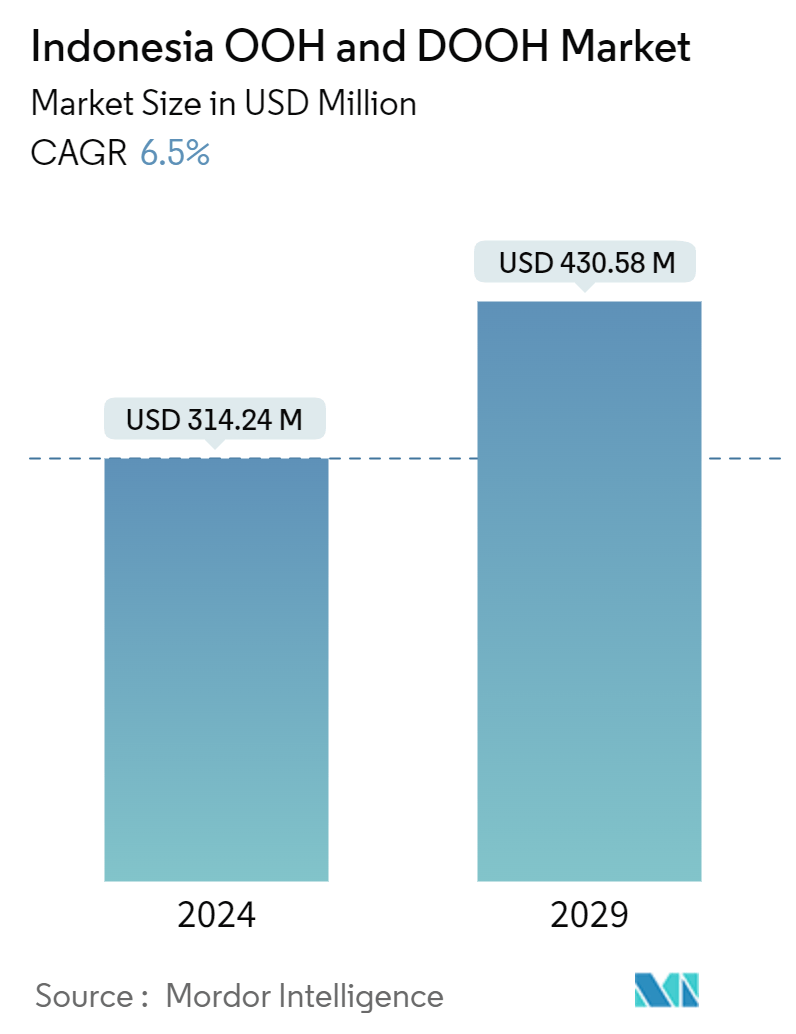
| Study Period | 2019 - 2029 |
| Base Year For Estimation | 2023 |
| Market Size (2024) | USD 314.24 Million |
| Market Size (2029) | USD 430.58 Million |
| CAGR (2024 - 2029) | 6.50 % |
| Market Concentration | Low |
Major Players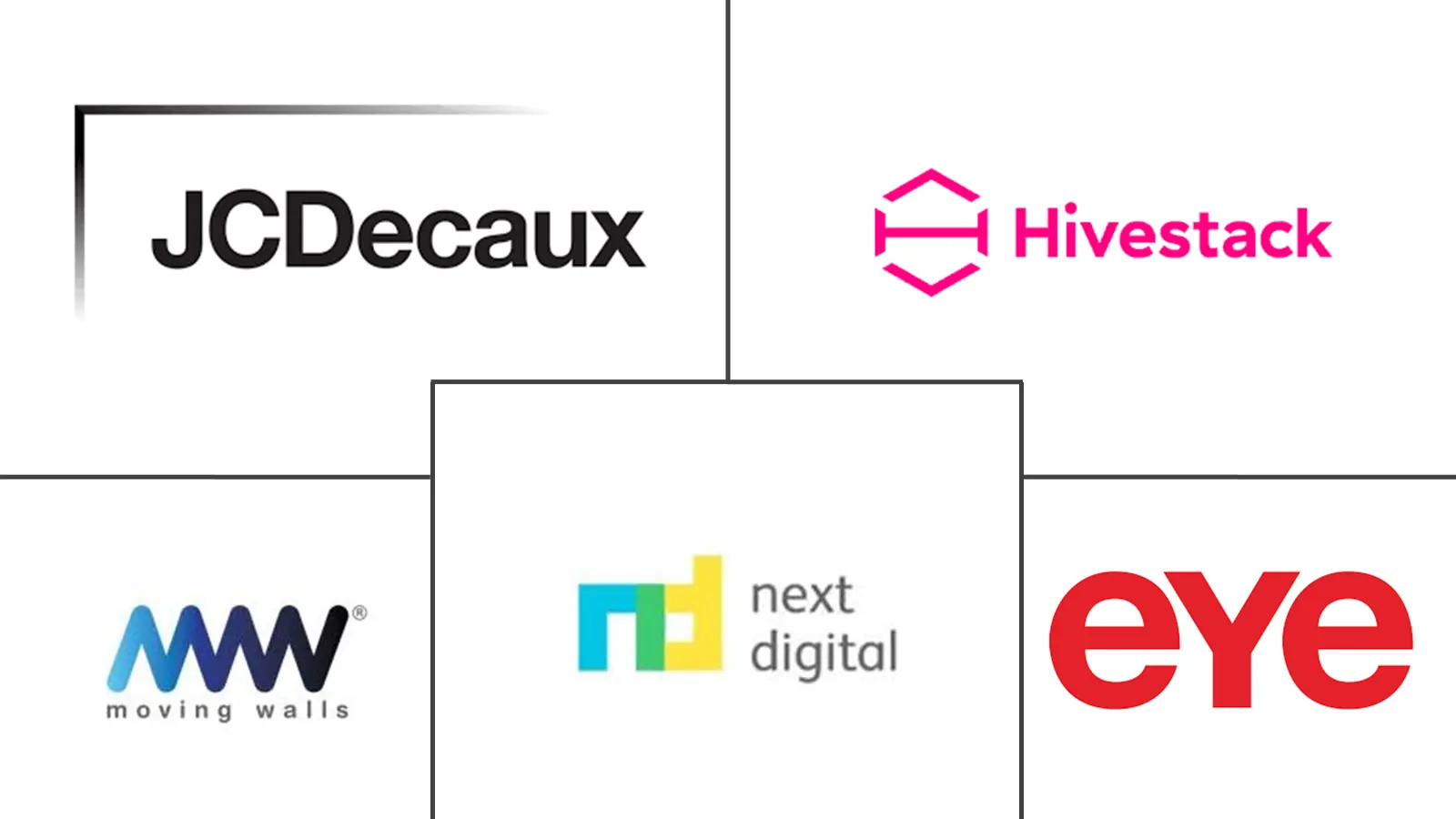
*Disclaimer: Major Players sorted in no particular order |
Indonesia OOH and DOOH Market Analysis
The Indonesia OOH And DOOH Market size is estimated at USD 314.24 million in 2024, and is expected to reach USD 430.58 million by 2029, growing at a CAGR of 6.5% during the forecast period (2024-2029).
- Rapid technological advancements and changing consumer behaviors are reshaping the digital out-of-home landscape in Indonesia. This transformation is set to bring a rise in interactive campaigns, deepening the connection between brands and their target audiences.
- The DOOH industry in Indonesia is witnessing a rapid transition toward digitalization. Digital billboards have become much more widespread in and outside of Indonesia. Combined with modern advertising technology, these dynamic displays have the same broad reach as traditional billboards but with the added advantage of providing deeper analytics capabilities.
- Digital out-of-home (DOOH) advertising is strategically placed for its ease of management, swift adaptability, cost-effectiveness, and precise market targeting. Advertisers utilize DOOH to distribute diverse information across networked devices, updating content remotely. This form of advertising allows for real-time adjustments and targeted messaging, making it a versatile tool in modern marketing strategies.
- In Jakarta, major OOH advertising locations include malls, commuter lines, airports, online taxis, MRTs, LRTs, and billboards in both commercial and suburban areas. Due to Jakarta's severe traffic congestion, advertising on online taxis, buses, and billboards has become highly popular.
- Quantifying user engagement with DOOH poses a challenge due to the inherent difficulty in pinpointing precise DOOH impressions. Although vendors leverage smartphone location data to estimate foot traffic around outdoor ads, this method lacks precision. Moreover, this approach falls short of incorporating facial recognition technology to determine the demographics of those exposed to the ads. This omission not only complicates implementation but also acts as an obstacle to the market's expansion.
Indonesia OOH and DOOH Market Trends
Ongoing Shift Toward Digital Advertising Aided by Increased Spending on Smart City Projects
- Digital advertising is proving to be a potent tool for businesses, aiding in customer acquisition and revenue diversification. Its pay-per-click model ensures cost-effectiveness, with businesses only paying when their desired campaign actions are taken. Moreover, its precise targeting features ensure that the right audience is prompted to act.
- Indonesian businesses are increasingly leveraging digital platforms, recognizing their pivotal role in the nation's advertising arena. Notably, end-user sectors like travel, tourism, and hospitality are spearheading initiatives to reignite consumer interest in travel. In a bold move, Tourism Indonesia rolled out a global campaign showcasing the nation's vibrant tourism offerings.
- Smart city initiatives utilize various digital displays to optimize urban operations, with each display offering potential revenue through advertisements. Digital signage technology is crucial in monetizing these opportunities. From small interactive kiosks to large digital billboards, these systems provide robust computing power, high-quality graphics, and seamless connectivity. They not only create a significant impact but also deliver essential analytics for informed decision-making.
- For instance, in May 2024, the US Trade and Development Agency signed a technical assistance grant with Indonesia's Nusantara Capital Authority (OIKN) to develop priority smart city infrastructure in Nusantara, Indonesia's new capital. These technologies will optimize government resources, increase sustainability, and improve the quality of life for the city's residents.
- The urban population in the country is on the rise, expanding the audience for DOOH displays. Although Indonesia's urbanization historically lagged behind global trends, it is now rapidly catching up. World Bank data shows that Indonesia's urbanization rate climbed from 55.33% in 2018 to 58.57% in 2023, with projections indicating a continued upward trajectory, bolstering market demand.
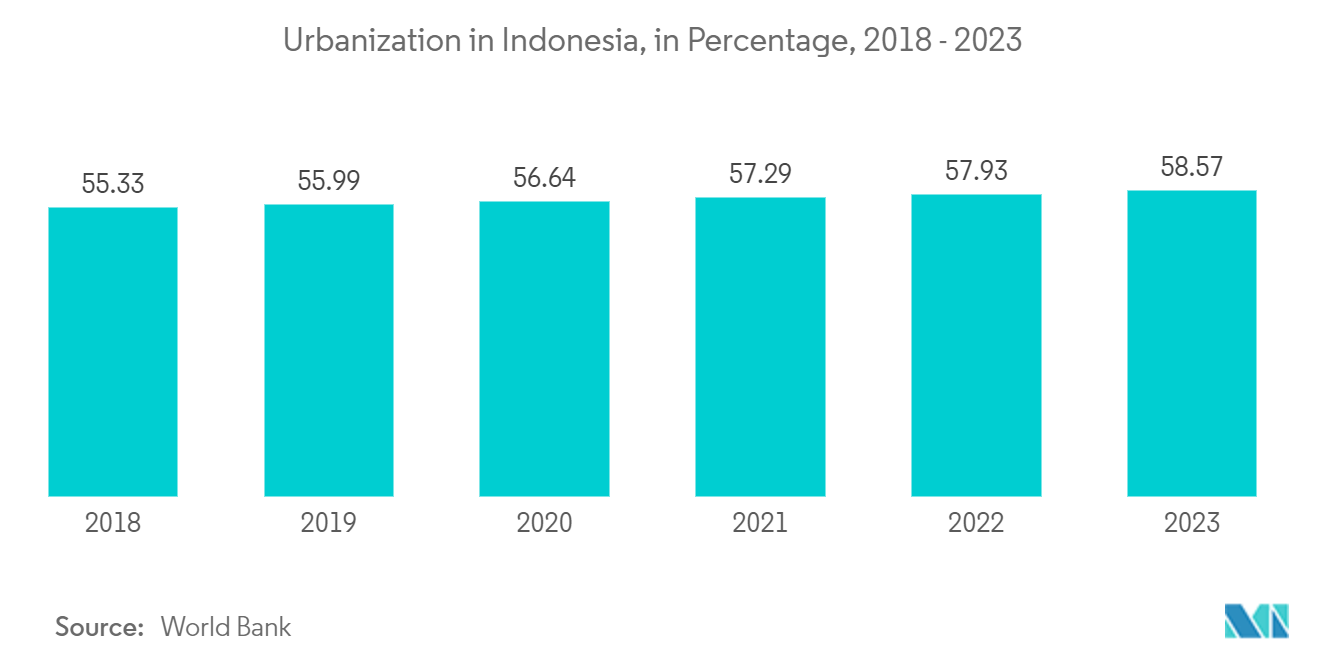
Retail and Consumer Goods Sector to Witness Major Growth
- Integrating in-store and retail DOOH advertising into an omnichannel marketing strategy creates a vital consumer touchpoint. This connection spans the shopper's entire journey, enhancing the overall experience with cohesion and consistency.
- According to a survey by Snapcart in Indonesia in 2023, the majority of respondents from Gen Z and Gen Y preferred online shopping platforms. Consumers’ growing interest in online shopping is compelling brands to attract more audiences.
- Bank Indonesia reported a notable rise in Indonesia's retail sales index, surging from 201.2 in February 2023 to 214.1 in February 2024. With this uptick in retail sales, brands are increasingly eyeing the potential for amplified advertising. Digital out-of-home (DOOH) emerges as a strategic avenue, allowing brands to precisely target consumers during their purchase decisions right at the point of sale.
- Engaging consumers is crucial for boosting retail sales. Interactive OOH advertising enhances this engagement by turning ads into interactive experiences. For instance, fashion retailers use interactive displays to allow consumers to browse collections and make purchases instantly, capturing their interest and encouraging immediate action.
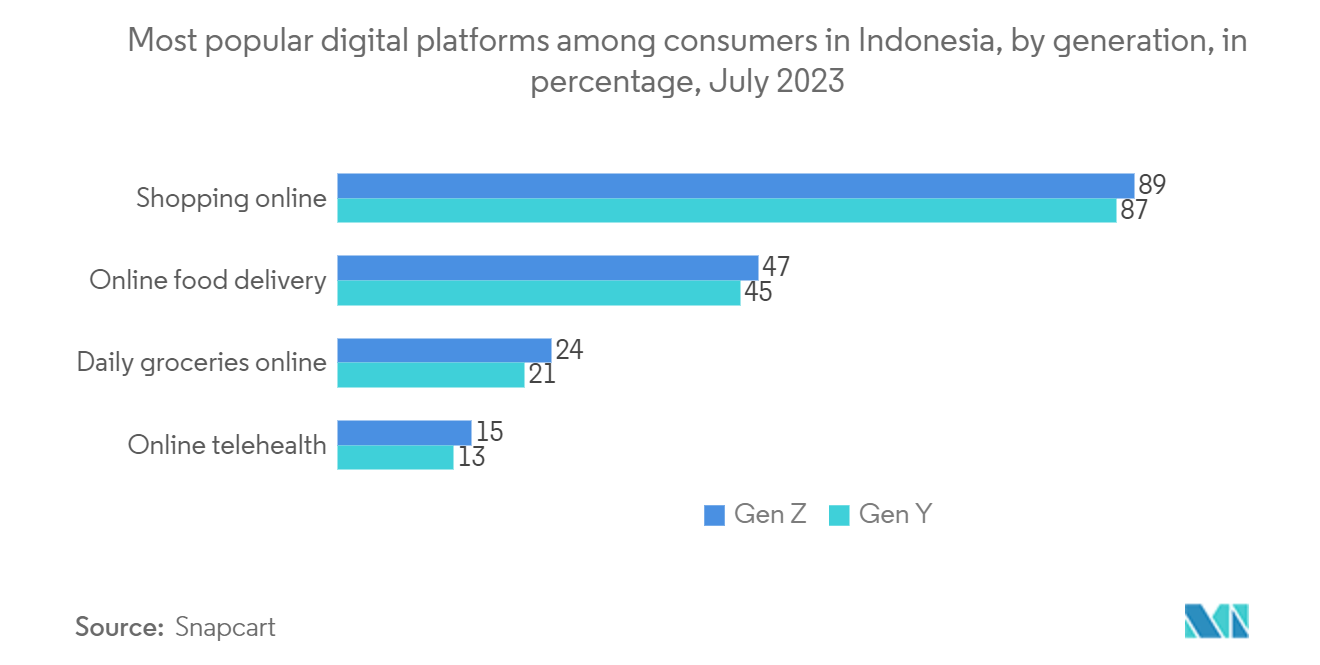
Indonesia OOH and DOOH Industry Overview
The Indonesian out-of-home (OOH) and digital-out-of-home (DOOH) market is fragmented. It comprises several major outdoor advertising and media companies with operations in multiple markets, as well as the smaller, local companies operating a limited number of structures in one or a few local markets. Some of the major players in the market are JCDecaux SE, EYE Indonesia, and Hivestack.
- April 2024: EYE Indonesia, an OOH advertising solutions provider, revealed its adoption of the Broadsign Platform. This strategic move aimed to enhance its offerings for media buyers in the region. With the integration of the Broadsign Platform, EYE Indonesia currently empowers its buyers with advanced features like share of voice, impression-based purchasing, and seamless programmatic transactions.
- April 2024: GroupM, a media investment firm, partnered with Moving Walls, a prominent global outdoor advertising tech provider, to revolutionize OOH advertising in Indonesia, leveraging audience data for precise planning, purchasing, and measurement. With Indonesia's OOH landscape expanding, GroupM Indonesia anticipates this collaboration will bolster brand trust in OOH.
Indonesia OOH and DOOH Market Leaders
-
JCDecaux SE
-
Hivestack
-
Next Digital Indonesia
-
EYE Indonesia
-
Moving Walls
*Disclaimer: Major Players sorted in no particular order
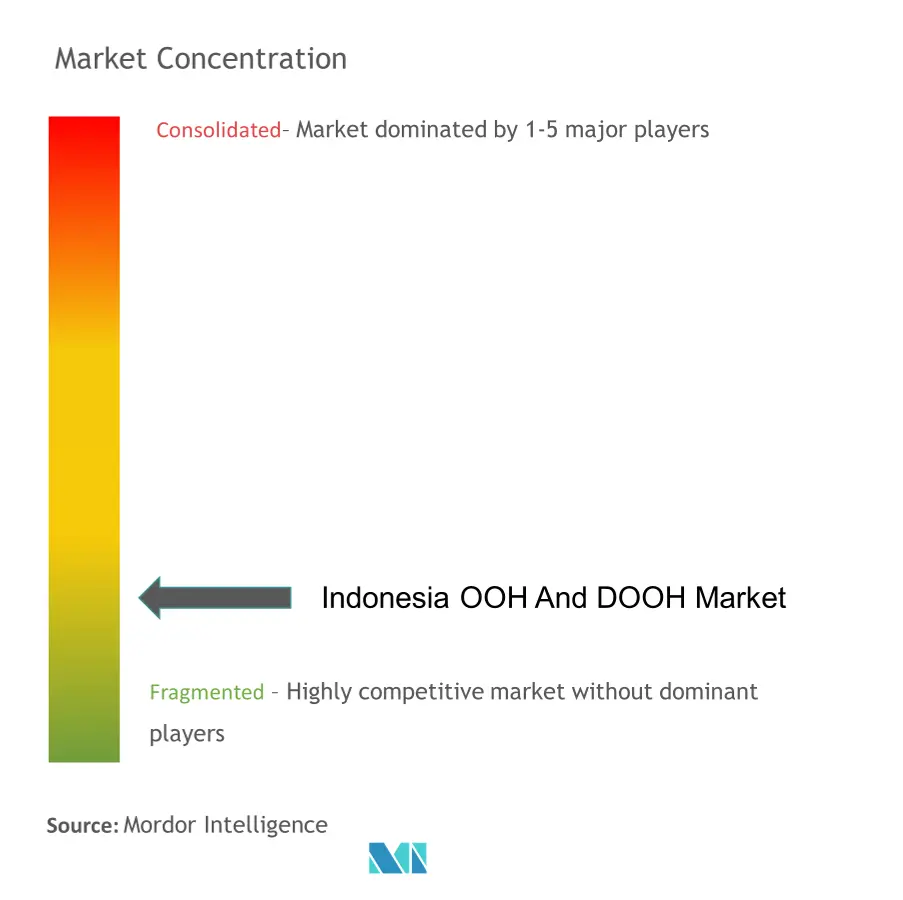
Indonesia OOH and DOOH Market News
- July 2024: Magnite, in collaboration with Dentsu Indonesia, rolled out a programmatic roadblock campaign on Indonesia's top streaming platforms – Viu, Vidio, and WeTV. This strategic move secured Magnite a 100% share of voice (SOV), ensuring unparalleled brand exposure. Concurrently, Nestlé Indonesia unveiled its latest offering, the limited-edition NESCAFÉ Biscuit Coffee featuring Marie Regal Biscuit. Recognizing the surging popularity of streaming platforms, Nestlé Indonesia partnered with Magnite and Dentsu Indonesia to amplify its audience reach.
- April 2024: inDrive, an Indonesian ride-hailing service, revamped its marketing efforts in Jakarta and several other key cities, partnering with The Perfect Media, an outdoor advertising company. inDrive also undertook mall branding at Central Mall Bandar Lampung, targeting a more focused exposure to mall-goers. Notably, inDrive highlights a unique feature of its app: allowing users to select their drivers and bid fairly.
Indonesia OOH and DOOH Market Report - Table of Contents
1. INTRODUCTION
- 1.1 Study Assumptions and Market Definition
- 1.2 Scope of the Study
2. RESEARCH METHODOLOGY
3. EXECUTIVE SUMMARY
4. MARKET INSIGHTS
- 4.1 Market Overview
-
4.2 Industry Attractiveness - Porter's Five Forces Analysis
- 4.2.1 Bargaining Power of Suppliers
- 4.2.2 Bargaining Power of Consumers
- 4.2.3 Threat of New Entrants
- 4.2.4 Competitive Rivalry Within the Industry
- 4.2.5 Threat of Substitutes
- 4.3 Industry Ecosystem Analysis
5. MARKET DYNAMICS
-
5.1 Market Drivers
- 5.1.1 Ongoing Shift Toward Digital Advertising
- 5.1.2 Increasing Use of Recommendation Engines
-
5.2 Market Restraints
- 5.2.1 Operational Challenges Related to the Measurement of Advertising Effectiveness, Cost, and Market Fragmentation
- 5.3 Market Opportunities
- 5.4 Industry Regulatory Landscape and Policy Developments
-
5.5 Key Technological Innovations
- 5.5.1 Innovations to Assess Audience Measurement and Analytics
- 5.5.2 Indication on Available Units (Spaces) in the Country (Based on Availability)
- 5.5.3 Likeliness of Audience Engagement Through Online Channels After Being Exposed to OOH Ads (Based on Availability)
- 5.5.4 Use of Digital Signage Screens for Advertisement in the Country
- 5.6 Key Case Studies of OOH and DOOH Advertisement Campaigns in the Country
- 5.7 Overall Positioning of OOH and DOOH Spending Amongst Other Advertisement Formats in the Country
6. MARKET SEGMENTATION
-
6.1 By Type
- 6.1.1 Static (Traditional) OOH
- 6.1.2 Digital OOH (LED Screens)
- 6.1.2.1 Programmatic OOH
- 6.1.2.2 Other Digital OOH
-
6.2 By Application
- 6.2.1 Billboard
- 6.2.2 Transportation (Transit)
- 6.2.2.1 Airports
- 6.2.2.2 Other Transportation (Buses, etc.)
- 6.2.3 Street Furniture
- 6.2.4 Other Place-based Media
-
6.3 By End-user Industry
- 6.3.1 Automotive
- 6.3.2 Retail and Consumer Goods
- 6.3.3 Healthcare
- 6.3.4 BFSI
- 6.3.5 Other End-user Industries
7. COMPETITIVE LANDSCAPE*
-
7.1 Company Profiles
- 7.1.1 JCDecaux SE
- 7.1.2 Hivestack
- 7.1.3 Next Digital Indonesia
- 7.1.4 Moving Walls
- 7.1.5 EYE Indonesia
- 7.1.6 Plan B Media Public Company Limited
- 7.1.7 VIOOH
- 7.1.8 Vistar Media
- 7.1.9 Jaris & K
- 7.1.10 Pixel Group
- *List Not Exhaustive
8. FUTURE OUTLOOK
** Subject To AvailablityIndonesia OOH and DOOH Industry Segmentation
Digital out-of-home (DOOH) advertising refers to dynamic, digital ads displayed in both indoor and outdoor public spaces. Essentially, it merges digital elements with conventional out-of-home advertising. Digital OOH has overtaken traditional offline out-of-home advertising.
The Indonesian OOH and DOOH market is segmented by type (static (traditional) OOH, digital OOH (LED screens), programmatic OOH, and other digital OOH), application (billboard, transportation (transit) (airports, other transportation (buses, etc.)), street furniture, and other place-based media), and end-user industry (automotive, retail and consumer goods, healthcare, BFSI, and other end-user industries). The market sizes and forecasts are provided in terms of value in USD for all the above-mentioned segments.
| By Type | Static (Traditional) OOH | |
| Digital OOH (LED Screens) | Programmatic OOH | |
| Other Digital OOH | ||
| By Application | Billboard | |
| Transportation (Transit) | Airports | |
| Other Transportation (Buses, etc.) | ||
| Street Furniture | ||
| Other Place-based Media | ||
| By End-user Industry | Automotive | |
| Retail and Consumer Goods | ||
| Healthcare | ||
| BFSI | ||
| Other End-user Industries |
Indonesia OOH and DOOH Market Research FAQs
How big is the Indonesia OOH And DOOH Market?
The Indonesia OOH And DOOH Market size is expected to reach USD 314.24 million in 2024 and grow at a CAGR of 6.5% to reach USD 430.58 million by 2029.
What is the current Indonesia OOH And DOOH Market size?
In 2024, the Indonesia OOH And DOOH Market size is expected to reach USD 314.24 million.
Who are the key players in Indonesia OOH And DOOH Market?
JCDecaux SE, Hivestack, Next Digital Indonesia, EYE Indonesia and Moving Walls are the major companies operating in the Indonesia OOH And DOOH Market.
What years does this Indonesia OOH And DOOH Market cover, and what was the market size in 2023?
In 2023, the Indonesia OOH And DOOH Market size was estimated at USD 293.81 million. The report covers the Indonesia OOH And DOOH Market historical market size for years: 2019, 2020, 2021, 2022 and 2023. The report also forecasts the Indonesia OOH And DOOH Market size for years: 2024, 2025, 2026, 2027, 2028 and 2029.
Indonesia OOH and DOOH Industry Report
Statistics for the 2024 Indonesia OOH And DOOH market share, size and revenue growth rate, created by Mordor Intelligence™ Industry Reports. Indonesia OOH And DOOH analysis includes a market forecast outlook for 2024 to 2029 and historical overview. Get a sample of this industry analysis as a free report PDF download.



